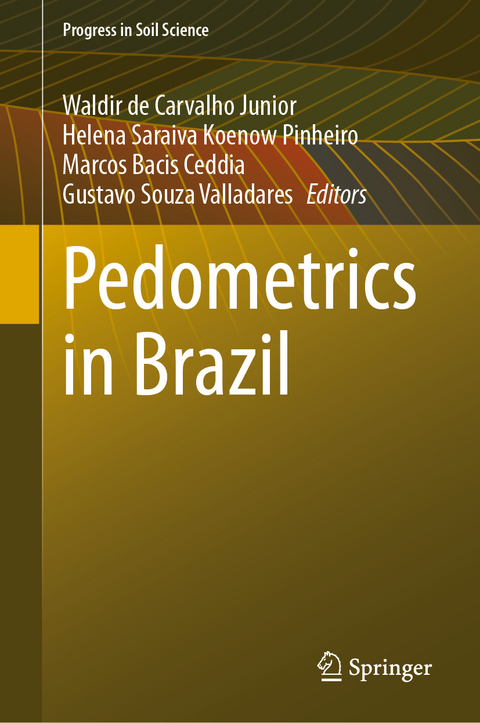
Pedometrics in Brazil
Springer International Publishing (Verlag)
978-3-031-64578-5 (ISBN)
In a world expected to reach a population of almost 10 billion inhabitants by 2050 and facing rapid global warming, it is essential to develop studies to better characterize and preserve the existing environmental heritage. Among these assets, soil stands out, which is fundamental for the balance of life on the planet (air quality and composition, temperature regulation, carbon and nutrient cycling, water cycling and quality, natural "waste" (decomposition) treatment and recycling, and habitat for most living things and their food). Due its importance, Soil information is increasing recently in order to attend human demands for land use management and capability, reduce erosion risks and soil security, for example. Particularly in Brazil, advances in soil science are now required to attend the new national systematic soil survey that have as a goal soil sustainability and security. Gathering machine learning tools, pedometrics and pedological concepts is a way to achieve these demands regarding soil data and related products. This book summarizes remarkable insights from the II Pedometrics Brazil Conference providing cutting-edge information to researchers, students and professionals working with soils in tropical countries such as Brazil.
Waldir de Carvalho Junior holds a degree in Agronomic Engineering from the Federal University of Lavras, Brazil, a Masters in Geography from the Federal University of Rio de Janeiro, Brazil, a PhD in Agronomy (Soils and Plant Nutrition) from the Federal University of Viçosa, Brazil and a post-doctorate at INRA, France. He is currently a researcher at the Brazilian Agricultural Research Corporation. He has experience in the field of Geosciences and Pedology, working mainly on the following topics: digital soil mapping, zoning, surveys and environmental diagnoses.
Helena S.K. Pinheiro is graduate in Geology and Forest Engineer, Master and PhD in Soil Science from the Federal Rural University of Rio de Janeiro, Brazil with a doctoral internship at Purdue University, USA. Currently she is Adjunct Professor at Soils' Department, Institute of Agronomy at UFRRJ, acting mainly on the following themes: reforestation, forest management, soil sciences (fertility, land use and capability, soil genesis and soil survey), modeling and geoprocessing applied to natural environments, digital soil mapping, pedometrics, diagnosis and survey of natural resources, integrated environmental assessment, analysis of environmental impacts, geological mapping and machine learning tools.
Marcos Bacis Ceddia is a full professor at the Department of AgroTechnologies and Sustainability (DATS-IA) at the Federal Rural University of Rio de Janeiro-UFRRJ. He has a doctorate in Agronomy-Soil Science from UFRRJ and a sabbatical period at the University of Florida (2014-2015) working in digital soil mapping. Currently developing teaching and research activities in the areas of soil physics, geostatistics, digital agriculture, agroecology, and soil security. Creator of the MultiSoils digital platform.
Gustavo Souza Valladares holds a degree in Agronomic Engineering, a Masters in Agronomy - Soil Science and a PhD in Agronomy all from the Federal Rural University of Rio de Janeiro with a Post-doctorate at State University of Campinas, Brazil. He is currently Associate Professor of Federal University of Piaui. He has experience in the field of Pedology and GIScience working mainly on the following topics: soil survey, GIS, environmental management.
Preface.- MultiSoils: a digital platform for information search and project management in soil science.- Multiscalar geomorphometric generalization to delineate soil textural paterns on amazon watersheds landscapes.- Applying machine learning techniques to model and map soil surface texture using limited legacy data.- Predicting soil physical-hydric attributes based on pedotransfer functions and algorithms for quantitative pedology.- Spatial dependence of organic carbon and granulometry in archaeological soils of lagoa grande das queimadas, northeastern brazil.- Application of electrical conductivity profiling for the characterization and textural discretization of a Technosol.- Soil porosity differences among grass-covered and exposed soils measured by high resolution X-ray computed microtomography (microCT).- Using legacy soil data to plan new data collection: Study case of Rio de Janeiro state Brazil.- Exploratory Analysis from Harmonized Legacy Soil Data to Support Digital Soil Mapping in Brazilian Midwest.- Soil organic carbon stock estimation using legacy data: a case study of north fluminense region BR.- Aerogeophysical data to modeling soil properties: a study case in Bom Jardim RJ.- Predicting and mapping of soil carbon and nitrogen stocks by diffuse reflectance spectroscopy and magnetic susceptibility in Western Plateau of São Paulo.- Iron rods as markers for soil horizon depths and point scatterers for estimating pulse velocity in GPR imagery.- Random forest-based fusion of proximal and orbital remote sensor data for soil salinity mapping in a brazilian semi-arid region.- The particle size causes a change in the determination of soil color via the Nix Pro 2 sensor.- Mapping soil salinity: a case study from Marajó Island, Brazilian Amazonia.- Applied Morphometry To Digital Soil Mapping In Detailed Scale.- Prediction of soil carbon stock in the Piaui State coast by remote sensing.- Methods and challenges in digital soil mapping: Applied modelling with R examples.
| Erscheinungsdatum | 13.09.2024 |
|---|---|
| Reihe/Serie | Progress in Soil Science |
| Zusatzinfo | XIII, 286 p. 118 illus., 117 illus. in color. |
| Verlagsort | Cham |
| Sprache | englisch |
| Maße | 155 x 235 mm |
| Themenwelt | Naturwissenschaften ► Geowissenschaften ► Geologie |
| Weitere Fachgebiete ► Land- / Forstwirtschaft / Fischerei | |
| Schlagworte | digital soil mapping • Machine Learning Applied to Soil Sciences • Pedometrics • Pedotransfer Functions • Soil attributes • Soil Classes • Soil surveys |
| ISBN-10 | 3-031-64578-2 / 3031645782 |
| ISBN-13 | 978-3-031-64578-5 / 9783031645785 |
| Zustand | Neuware |
| Haben Sie eine Frage zum Produkt? |
aus dem Bereich


